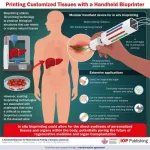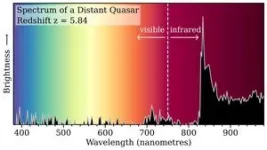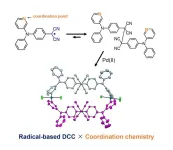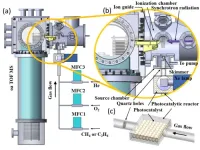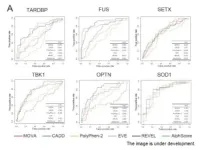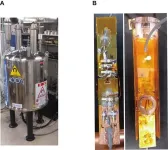(Press-News.org)
In situ bioprinting, which involves 3D printing biocompatible structures and tissues directly within the body, has seen steady progress over the past few years. In a recent study, a team of researchers developed a handheld bioprinter that addresses key limitations of previous designs, i.e., the ability to print multiple materials and control the physicochemical properties of printed tissues. This device will pave the way for a wide variety of applications in regenerative medicine, drug development and testing, and custom orthotics and prosthetics.
The emergence of regenerative medicine has resulted in substantial improvements in the lives of patients worldwide through the replacement, repair, or regeneration of damaged tissues and organs. It is a promising solution to challenges such as the lack of organ donors or transplantation-associated risks. One of the major advancements in regenerative medicine is on-site (or ‘in situ’) bioprinting, an extension of 3D printing technology, which is used to directly synthesize tissues and organs within the human body. It shows great potential in facilitating the repair and regeneration of defective tissues and organs.
Although significant progress has been made in this field, currently used in situ bioprinting technologies are not devoid of limitations. For instance, certain devices are only compatible with specific types of bioink, while others can only create small patches of tissue at a time. Moreover, their designs are usually complex, making them unaffordable and restricting their applications.
In a breakthrough study published in Biofabrication, a research team including Mr. Erik Pagan and Associate Professor Mohsen Akbari from the University of Victoria in Canada, developed a handheld in situ bioprinter with a convenient modular design, that allows the printing of complex biocompatible structures. “Two decades ago, my mother was diagnosed with breast cancer, which eventually led to the removal of her breast. This affected her well-being considerably. It made me realize that a technology like handheld bioprinting could not only help develop personalized implants for breast reconstruction that match the shape and size of the patient’s tissue, but also be used to create tumor models for the study of breast cancer biology. Such applications could significantly improve treatment outcomes for affected patients,” says Prof. Akbari while discussing his motivation underlying this study.
A key feature of the handheld device is the presence of multiple bioink cartridges, each independently controlled by a pneumatic system. Owing to this, the device operator has ample control over the printing mixture, making it easier to develop structures with the required properties. Moreover, the device has a cooling module and a light emitting diode photocuring module, which provide additional control.
This versatile in situ bioprinter has several applications. Prof. Akbari elaborates, “In situ bioprinting is suitable for repairing large defects caused by trauma, surgery, or cancer, which requires large-scale tissue constructs. In the long term, this technology can eliminate the need for organ donors, while also lowering the risks associated with transplantation, allowing patients to enjoy longer and healthier lives.”
Another notable potential application of this device is the production of drug delivery systems. An operator could construct scaffolds or structures that release a precise quantity of drugs as well as cells at specific locations within the body. This would make drugs more efficient, minimize side effects associated with them, and improve their safety. The technology reported in this paper may also speed up the discovery of new drugs by allowing scientists to develop more accurate drug testing models.
What’s more, it has the potential to develop custom prosthetics and orthopedic implants. Due to its portable nature, this bioprinter may help physicians match a patient’s tissue anatomy with greater accuracy and convenience, thus enhancing the functionality and aesthetic of the bioprinted construct.
The findings of this study can significantly benefit researchers and physicians dedicated to improving the scope of regenerative medicine and enable collaborative research, which can accelerate further development of this technology. Keeping this in mind, Prof. Akbari and his team published this study through a transformative agreement between IOP Publishing and the Canadian Research Knowledge Network. This agreement enables authors to publish their work in more than 70 IOP Publishing journals at no cost to them. These articles are immediately available and free for everyone to access. “By publishing under a transformative agreement, we are promoting a more sustainable and equitable scholarly publishing model that benefits the entire research community. This can address long-standing challenges of access and affordability in academic publishing while also promoting the growth of scientific knowledge,” remarks Prof. Akbari.
END
Women suffering from the autoimmune disease multiple sclerosis temporarily get much better when pregnant. Researchers have now identified the beneficial changes naturally occurring in the immune system during pregnancy. The findings, published in Journal of Neuroinflammation, can show the way to new treatments.
Pregnancy is a very special condition from an immunological point of view. The immune system serves to defend us against foreign substances. However, although half of the genetic material of the foetus ...
People who adhere to global Cancer Prevention Recommendations are putting themselves at lower risk of developing the disease, new research confirms.
Experts at Newcastle University have reviewed evidence of following the 2018 World Cancer Research Fund (WCRF) and American Institute for Cancer Research (AICR) lifestyle-based recommendations.
The findings, published today in Cancer, revealed that adhering to a healthier lifestyle, including maintaining a healthy body weight and eating little red meat and processed meats such as bacon, helps ...
A research group led by Professor Hideki Fujiwara and Associate Professor Daisuke Sakamaki from the Graduate School of Science at Osaka Metropolitan University succeeded, for the first time, in synthesizing a new molecule using a novel combination of dynamic covalent chemistry, in which organic radicals couple and dissociate reversibly, and coordination chemistry, which binds radicals to metal ligands. The study shows that the two types of reactions work without inhibiting each other.
“This research was based on a very simple idea of combining two types of reactions,” stated Professor Sakamaki. “However, it was not clear ...
Increased levels of Lipoprotein(a), a variant of ‘bad cholesterol’, in the bloodstream are a risk factor for recurrent coronary heart disease (CHD) in people aged 60 or over, according to the results of a new study which tracked the issue over the course of 16 years.
The results, published today in Current Medical Research & Opinion, suggest that current cholesterol-lowering medications may not be effective at reducing the risk of recurrent CHD – such as a heart attack – due to elevated Lp(a).
“This finding adds to growing evidence of a relationship between increased Lp(a) and the risk of recurrent CHD,” says lead author Associate Professor ...
Prof. PAN Yang and Associate Researcher LIU Chengyuan, researchers from the University of Science and Technology of China (USTC) of the Chinese Academy of Sciences (CAS), have achieved significant progress in detecting intermediates in methane photocatalytic reactions. Their technique, Synchronous Radiation Photoionization Mass Spectrometry (SR-PIMS), allows for in-situ detection of active intermediates. The findings were published in the prestigious chemistry journal Angewandte Chemie International ...
A team led by Academician Prof. GUO Guangcan from the Chinese Academy of Sciences (CAS) provides a comprehensive overview of the progress achieved in the field of quantum teleportation. The team, which includes Prof. HU Xiaomin, Prof. GUO Yu, Prof. LIU Biheng, and Prof. LI Chuanfeng from the University of Science and Technology of China (USTC),CAS, was invited to publish a review paper on quantum teleportation in Nature Review Physics. The paper was officially released online on May 24.
As one of the most important protocols in the field ...
A point-to-point long-distance quantum key distribution (QKD) over a distance of 1,002 km has been achieved by scientists from the University of Science and Technology of China (USTC) of the Chinese Academy of Sciences (CAS), and their collaborators from Tsinghua University, Jinan Institute of Quantum Technology, and Shanghai Institute of Microsystem and Information Technology (SIMIT), CAS. This milestone not only sets a new world record for non-relay QKD but also provides a solution for high-speed intercity quantum communication. The ...
Posters
All poster presentations will take place on Monday, June 12, 2023, from 12:15 to 1:30 p.m. EDT, or Tuesday, June 13, 2023, from 12:15 to 1:30 p.m. EDT at the Baltimore Convention Center, Exhibit Hall E, Level 100.
Abstract 4-M (Monday)
Avoiding Clinical Inertia: Comparing Time to Intensification of Glucagon-like
peptide-1 (GLP-1) Receptor Agonists in Patients with Type 2 Diabetes Mellitus Among Clinical Pharmacists versus Providers
Clinical pharmacists have a significant impact on medication optimization and reduction ...
Niigata, Japan - The Department of Neurology at Niigata University has developed a new in silico method for evaluating the pathogenicity of missense variants using AlphaFold2 (MOVA). Rare variants in the causative gene of ALS are present in 10-30% of sporadic ALS cases, which highlights the need for accurate and efficient pathogenicity prediction methods. To predict the pathogenicity of the variants, in silico analysis methods are commonly used. In some ALS causal genes, the mutations are concentrated in specific regions, and the accuracy of pathogenicity prediction can be improved by considering the positional information of the variants. ...
Niigata, Japan - The gold standard test for predicting the onset of diabetic kidney disease is albuminuria. However, detecting albuminuria alone has limited sensitivity and specificity in end-stage renal failure with a decreased estimated glomerular filtration rate. This is supported by several reports, which state that about half of the type 2 diabetes patients who developed kidney dysfunction showed no preceding albuminuria.
In this study, the authors propose the possibility of diagnosing tubular abnormalities in diabetic kidney disease at an early stage and connecting them to treatment by combining the evaluation of sodium concentration using 23Na MRI ...
